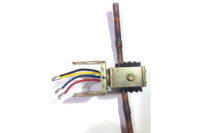However, these symptoms are for a system with a conventional thermostatic expansion valve (TXV) as the metering device. What if the system has an automatic expansion valve or a capillary tube as the metering device? Would the symptoms for an overcharge of refrigerant be any different? The answer is yes! Let’s explore some differences.
AUTOMATIC EXPANSION VALVE
The symptoms for an overcharge of refrigerant with a system incorporating an automatic expansion valve (AXV) are:• High discharge temperatures;
• High condenser subcooling;
• High condensing pressure;
• High condenser splits; and
• Normal evaporator pressures.
Notice that the only difference in symptoms for an overcharged system between a TXV and an AXV metering device is in the evaporator pressure. The evaporator pressure is normal for the AXV and high for the TXV when the system is overcharged.
This happens because the AXV’s function in a system is to hold a constant evaporator pressure no matter what the system conditions are. It does this by either starving or feeding the evaporator with refrigerant in response to the slightest change in evaporator pressures. In this case, the AXV holds a constant evaporator pressure even when the system is overcharged with refrigerant.
On the other hand, the conventional TXV’s function is simply to control evaporator superheat, and does not have any control over changing evaporator pressures. TXV systems allow evaporator pressures to rise a bit when the system was overcharged because of a lower system capacity when the condensing pressure rose from the overcharged system. This rise in condensing pressure caused a higher compression ratio, thus a lower volumetric efficiency, which will cause the box temperature to rise. An extremely high condensing pressure may also be out of the operating pressure range of the TXV. The TXV may now overfeed the evaporator and cause high evaporator pressures.
CAPILLARY TUBE METERING DEVICE
What if the system incorporated a capillary tube as the metering device and was overcharged with refrigerant? Would the symptoms again be different than that of the conventional TXV system when overcharged? The answer is yes, again. Symptoms for a capillary tube system when overcharged are:• High discharge temperatures (unless wet compression takes place);
• High condenser subcooling;
• High condensing pressure;
• High condenser splits; and
• Much higher evaporator pressures.
Again, the only difference in symptoms is the evaporator pressure. When overcharged, the capillary tube system will run a much higher evaporator pressure than a conventional TXV system with an overcharge. The reason being that any liquid refrigerant in excess of the capillary tube’s critical charge will be backed up in the condenser. This will cause less condenser internal volume to desuperheat, condense, and subcool the refrigerant in the condenser.
The condenser pressure will then rise, pushing more liquid from the bottom of the condenser through the capillary tube to overfeed the evaporator. This causes much higher evaporator pressures and a very low evaporator superheat. If the rise in condensing pressure is severe enough, an enormous amount of subcooled liquid from the bottom of the condenser will be pushed through the capillary tube, causing flooding of the crankcase, or slugging in the compressor’s cylinder.
When the compressor slugs liquid, wet compression takes place and the discharge temperature will be much cooler than normal. This happens because as the liquid droplets of refrigerant vaporize in the cylinder of the compressor on the upstroke, they absorb tremendous amounts of heat from the cylinder walls and from the heat of compression. This gives a lower discharge temperature. In severe slugging cases, the discharge temperature is often lower than the condensing temperature.
Publication date:12/06/2010






